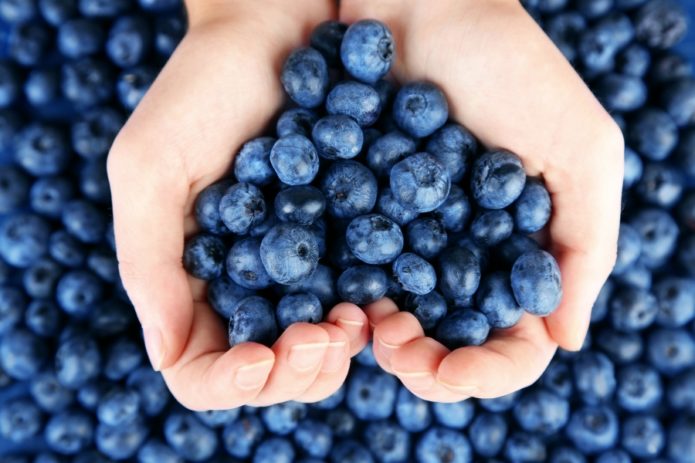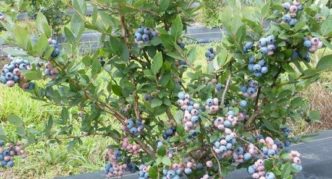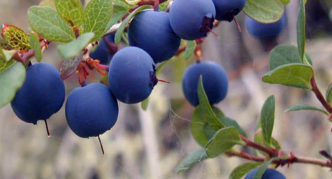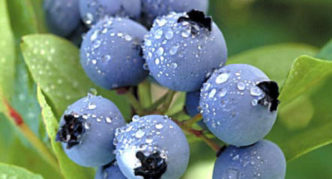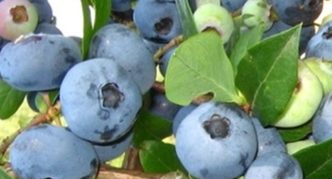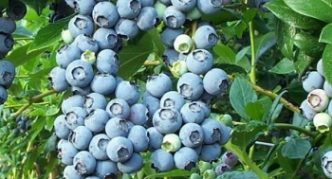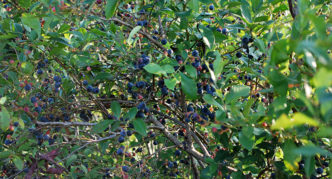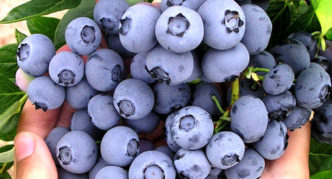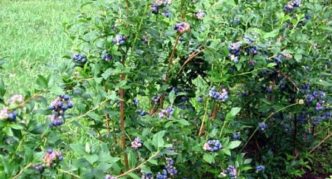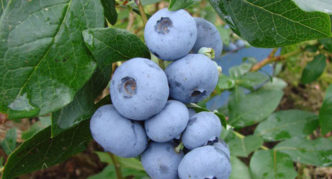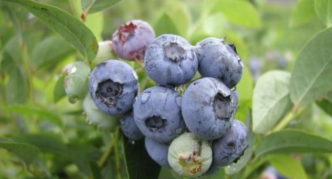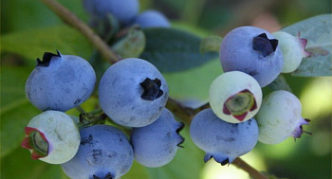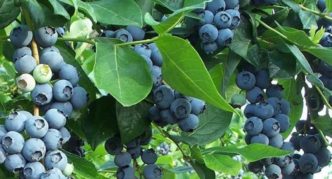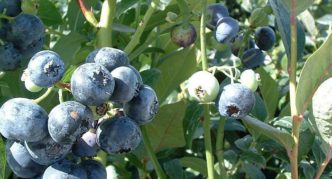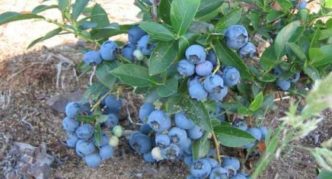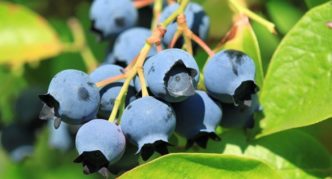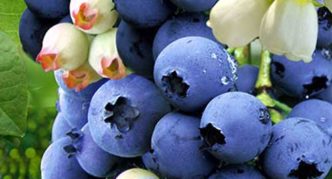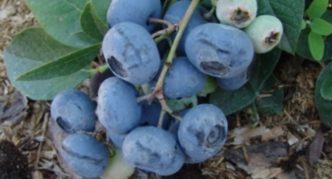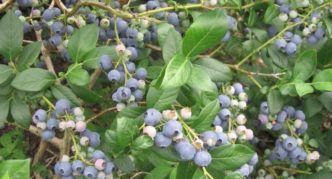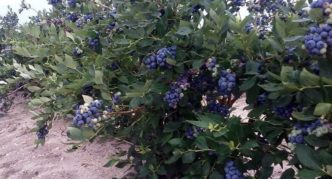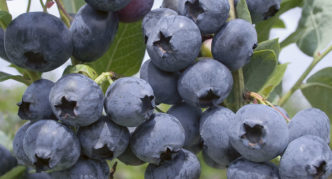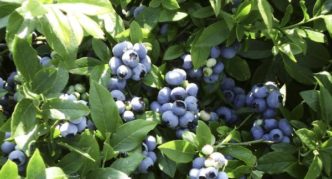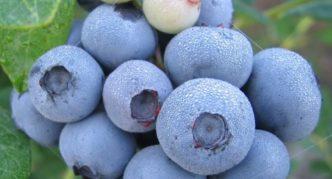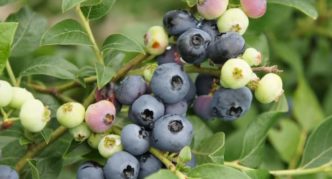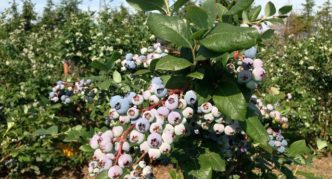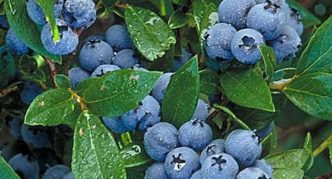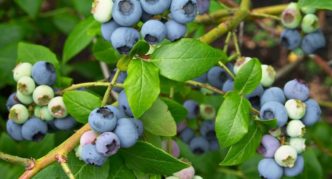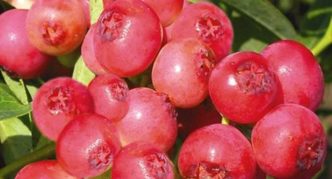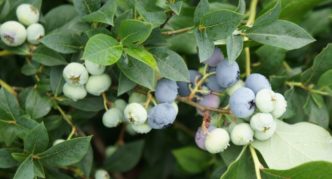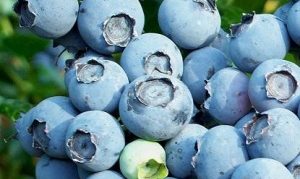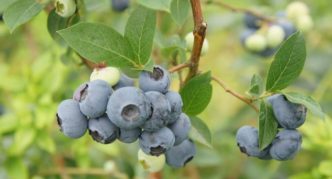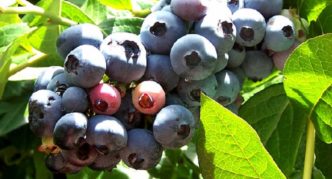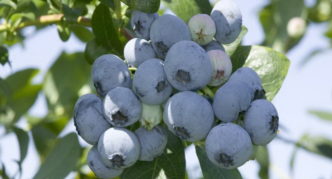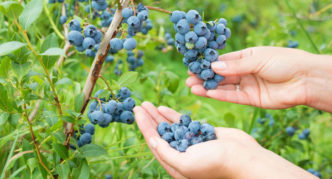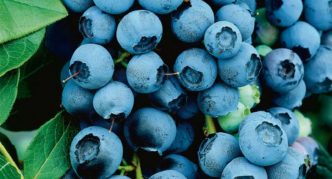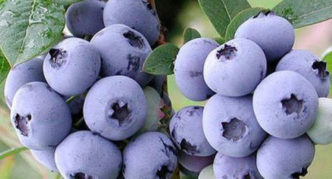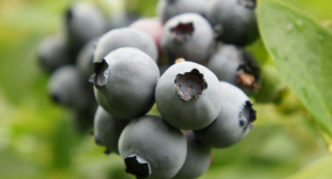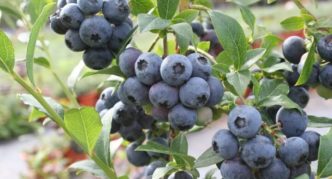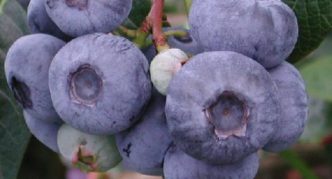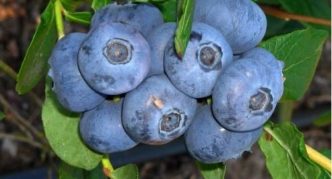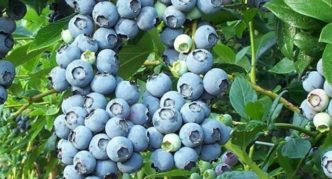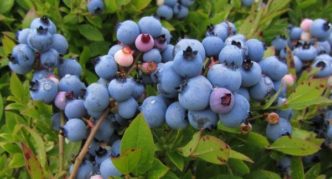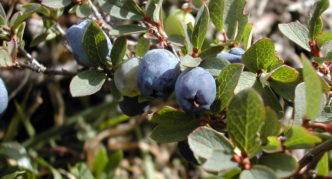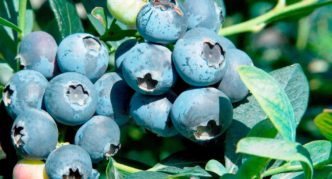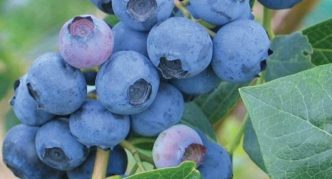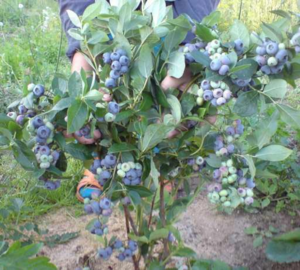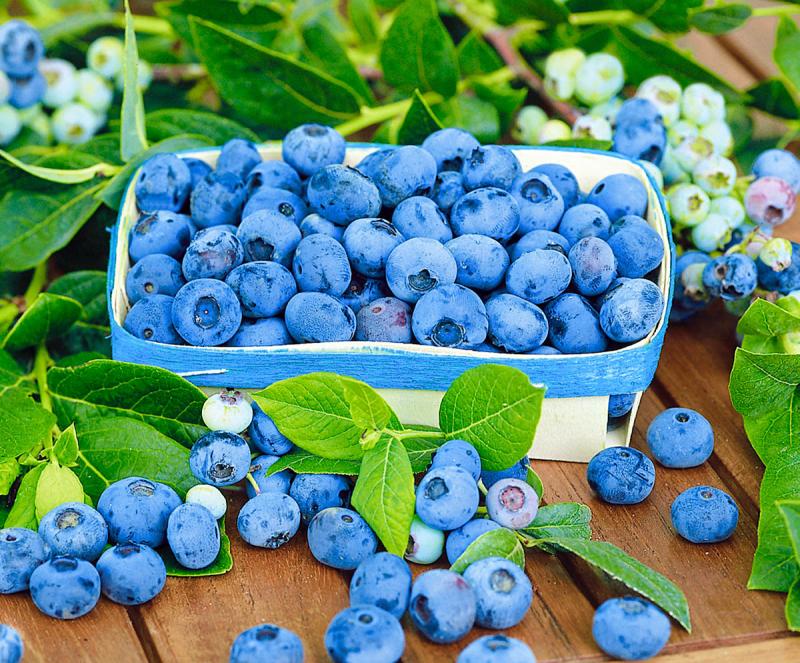Blueberries are a small berry with a deep blue color - not only pleasing to the eye, but also of great benefit to the body: it helps to reduce blood sugar, strengthen blood vessels, improve metabolism, and contains a large amount of vitamins. From a wide variety of varieties, you can choose the one that best suits your region.
Content
Blueberry species
Blueberry is a branchy shrub up to 1 m high (varietal plants are higher). The stem is almost completely woody. The appearance of blueberries and blueberries is very similar, but the berries of the former are larger. The following plant types are distinguished:
- undersized. Distributed in Canada, North America and Scandinavia. Due to the difficulties of care and reproduction, as well as the high cost of planting material, it is not popular for cultivation. The growing season is shorter than that of other species. Bushes are low (up to 50 cm), berries are small, rich in antioxidants;
- northern tall blueberry... Frost resistant, late bloom. For good fruiting, this species needs cold. Demanding on soils (prefers light, well-fertilized) and watering (drainage is required);
- southern tall. This type of blueberry does not tolerate frost well, but also needs lower temperatures for a good harvest. It is grown in the southern regions. Combines the characteristics of a tall northern species with drought tolerance and tolerance to very acidic soils. Southern species are not suitable for the north, since they have a rather long growing season;
- semi-tall. This species tolerates very low temperatures (up to -35aboutC), therefore it is intended for the north. The growing season is short;
- rabbit eye. Tall plant (up to 2.5 m) intended for the south. Long growing season and, as a result, unsuitable for northern regions. Acidic soils are required. It tolerates drought well and poorly fertilized soils. Berries are stored much better than other types.
Varieties
Breeders have developed quite a few varieties that satisfy a variety of requirements:
- Aurora. Up to 1.5 m high, self-pollinated, it belongs to the tall northern species. Spreading branches; blooms with small white flowers. Productivity up to 3.5 kg per bush, ripens in August, medium-sized berries. Considered dessert;
- Alvar. Northern tall variety, originally from Finland, tolerates frost well. Up to 1 m in height. The yield is high. Any other variety is suitable for pollination;
- Ama. Tall southern, grows about 2 m in height, collection up to 10 kg. Cold resistance is weak, in the northern regions it is recommended to wrap it up for the winter. Prefers light, acidic soils. Ripening time - August;
- Atlantis. Semi-tall variety, 1.5 m tall. The berries are large and sweet. Easily survives the worst frosts (up to -40aboutFROM). Loves acidic, fertile soils. It ripens in the middle of summer;
- Berkeley. Tall shrub. Large berries ripen in July. Up to 8 kg are harvested from the bush. Unpretentious to soil;
- Blue Berry. It is a high-yielding variety with medium-sized berries that ripen in July. Withstands frosts down to -35aboutFROM;
- Blue Giant.Low bush, yield up to 5 kg per plant. The size of the berries is large, the taste is sweet. Frost resistance is high. The bush grows up to 70 cm;
- Blue Jay. A shrub producing up to 6 kg of fruit is considered early, the fruits ripen in July. The berries are large and sweet. Not afraid of diseases and frost. A pollinator variety is required;
- Blue Test. The variety is resistant to sudden changes in temperature, but in the north it can freeze slightly. In especially cold weather, it may even die. The height of the bush reaches 1.5 m, the berries are medium-sized, ripen in August;
- Blue Etta. Height - up to 1.2 m. Berries ripen in early July. Harvest up to 9 kg per bush, berries are large, dark blue, sweet. High frost resistance;
- Boniface. Up to 2 m in height, strong, columnar bush, late blooms, hardy. The berries are medium or large, sweet and sour;
- Brigitte Blue. Late grade. Blossoms in May, ripens in mid-August, yield up to 6 kg. The fruits are sweet, large, dense;
- Weymouth. The bush is up to 1.6 m high. The variety is very early, ripens in the middle of summer. The berries are spherical, with a mild taste. Cannot be transported;
Blueberry Patriot is not just one of the tall family, but the best among them:https://flowers.bigbadmole.com/en/yagody/golubika-patriot-opisanie-sorta.html
- Goldtraube. Unpretentious, hardy, frost-resistant. Early variety. The height of the bush is up to 3 m. The collection is about 3.5 kg. Withstands frosts down to -29aboutFROM;
- Blue scattering. The variety is frost-resistant, not afraid of pests and diseases. Up to 1 m in height. The berries are medium-sized, round, sweet and sour. Harvest up to 4 kg per bush;
- Blue fruitful. Bountiful harvest and sweet, quality berries. The variety is very resistant to frost and during flowering. The height of the bush reaches 2 m. Pruning is required;
- Huron. A straight shrub that can grow up to 1.5 m. It blooms late and matures. Self-pollinating. The berries are large, sweet, rich in color, well stored;
- Double. A feature of the variety is the gradual ripening of fruits from July to August. Takes up to -35aboutC. Not afraid of pests and diseases. The berries are large and sweet;
- Darrow. Bush up to 2.2 m tall. Harvest up to 8 kg. The berries are large, poorly stored. Dislikes shaded areas;
- Denise is blue. High resistance to frost and temperature changes. The berries are pinkish, sweet, large, ripen at the end of July;
- Jersey. The berries are small, sweetish-sour, up to 6 kg are harvested from the bush, best suited for jams. The best pollinator for other varieties. The bush is up to 2 m in height, the crown is wide. Resistant to frost;
- Kaz Plishka. Very demanding on the soil (prefers sour peat), likes partial shade. Dessert berries, round, dark blue, ripen in August. Bush up to 1.8 m in height;
- Canadian nectar. The berries are very tasty, deep blue, large. The bush gives 6 kg of berries. Grows up to 2 m in height. The variety is frost-resistant, well resistant to diseases;
- Legacy. Late variety, one of the highest yielding varieties. Straight bush, up to 2 m in height. The berries are medium, with a good taste. Best suited for moderate conditions with non-severe winters;
- Meader. One of the most unpretentious varieties, suitable for harsh climates. Not afraid of diseases and frost. Berries are large and sweet, and are considered dessert. Begins to bear fruit early. The bush is high, up to 2 m;
- Nelson. Late variety, ripens at the end of August, pick up to 9 kg of berries from the bush. From this variety, beautiful and strong hedges are obtained;
- North country. The bush is low, about 70 cm high. The berries ripen in early August. Collecting up to 2 kg from a bush, fruits of medium size, light, sweet. It tolerates frost well, is decorative, suitable for northern regions;
- Northland. Rounded dense bush up to 1.3 m in height. The variety is early, the harvest ripens in mid-July. Up to 8 kg of sweet fruits are harvested from one plant. Can be grown in the north;
- Pink lemonade. Fuchsia berries. The bush is dense, up to 3.5 m in height. The flowers are large, white and pink. The bush gives up to 4.5 kg of berries, which ripen at the end of August. Self-pollinating. The plant needs to be wrapped up for the winter, not suitable for growing in cold regions;
- Polaris. Very frost resistant. Bush up to 1.4 m in height.The berries are medium, aromatic, up to 2 kg per bush. Needs a pollinator variety;
- Puru. Straight bush, up to 2 m in height. Harvest of large, shiny, well-stored sweet berries - up to 7 kg per plant. Puru leaves are covered with a waxy coating that protects them from many pests. Easily withstands any weather conditions;
- Putte. The bush is up to 70 cm in height, the berries are medium-sized. It came from a wild variety, therefore it is very frost-resistant. Berries are aromatic, with a protective wax coating, sweet;
- Rankocas. The bush is dense, grows rapidly, reaching up to 1.8 m in height, and multiplies quickly. Fruits ripen at the end of summer, berry picking - about 6 kg per bush. Looks great in hedges. Unpretentious, resistant to extreme weather conditions and pests. Cropping is required. Abundant fruiting sometimes leads to breakage of shoots;
- River. Straight, slender bush up to 1.5 m in height. The harvest of berries, which have a large size and sweet-sour taste, up to 8 kg per bush, ripens at the end of August. Not damaged in transit. Resistant to disease. For good fruiting, the bush must be cut;
- Sweet Grape. Bushes are strong, up to 2 m in height. The berries grow in bunches like grape, sweet, turquoise, large, ripen in early August. Up to 9 kg of fruits are harvested from the bush. The variety tolerates frosts down to -35aboutS. Decorative;
- Northern country. Despite its dwarfism (up to 50 cm in height), this variety can withstand temperatures down to -40aboutC. Berries are small, they ripen on a bush up to 3 kg. The variety requires fertilization;
- Sierra. The bush is sprawling, strong, grows up to 1.5 m. Flowers grow in buds. The fruits are considered to be very large, flattened, fragrant. The end of July is the ripening deadline. -26aboutС - stability threshold;
- Spartan. A straight, dense, strong shrub, can grow up to 2 m. Despite its late flowering, it is considered an early variety - it ripens in mid-July. Collect up to 5 kg from the bush. Light blue berries taste sweet and sour, dense, tolerate transportation well;
- Toro. The bush is small in width, up to 2 m in height. Small sweet berries ripen at the end of summer. The variety has high resistance to frost and disease;
- Hannas Choice. Self-pollinated dessert variety. The berries are sweet and sour, medium in size. Frost resistance up to -35aboutFROM;
- Herbert. It grows as a powerful bush up to 2.1 m in height. Resistant to frost. Reproduces easily. The berries are very large, firm, slightly flattened, they taste tender, sweet and aromatic, they can be collected from one bush up to 10 kg. The harvest ripens in August. Herbert is considered one of the best varieties;
- Chanticleer. The columnar bush reaches 1.6 m in height. Fruits ripen in early August, medium-sized, round, light blue. Resistant to disease, for the winter the bush is usually wrapped;
- Chandler. Dense and branched bush 1.5 m tall. The large size of the berries and the yield distinguish this variety. The berries ripen for a month, from August to September. Best suited for temperate climates;
- Chippewa. It grows up to 100 cm. Delicious berries ripen early, very sweet. This variety can withstand frost down to -30aboutFROM;
- Elise. The bush grows up to 1.2 m. The largest yield is 6 kg per bush. The berries are medium or small, sourish, stored for a long time. The plant is resistant to fungal diseases and frost;
- Elliot. Usually up to 2.2 m high. The berries ripen at the end of summer. Collection up to 8 kg from a bush. Berries of medium size, tasty, blue in color, have a delicate soft aroma;
- Erliblu. The columnar bush can grow up to 1.3 m. Advantages - unnecessary pruning and easy reproduction. The berries usually ripen in early July. You can get 7 kg from a bush. They are not stored for long, it is undesirable to transport.
Growing varieties of garden blueberries for the Moscow region:https://flowers.bigbadmole.com/en/yagody/vyraschivanie-sortov-sadovoy-golubiki-dlya-podmoskovya.html
Photo gallery: popular blueberry varieties
- Aurora blueberry bush grows up to 1.5 m
- Alvar blueberries are sweet and rich in vitamins
- In the northern regions, Ama blueberries need to be covered for the winter.
- Blueberry Atlantis produces large berries
- Berkeley blueberries gathered in large bunches
- Blueberry blueberries withstand severe frosts
- Coin-sized Blue Giant Berries
- Blue Jay requires a pollinator
- Blue Swedes may freeze in the north
- Blue Etta has very sweet berries
- Boniface variety - northern tall
- Blueberry Brigitte blue - late variety, ripens in August
- Blueberry Weymouth does not tolerate transportation
- Goldtraube blueberries are great for the north
- The Blue Scatter variety is not afraid of pests and diseases
- Blueberry blueberries need pruning
- Huron berries are perfectly stored
- Feature of double blueberry - long-term fruiting
- Darrow variety grows poorly in shade
- Blueberry Denise blue - frost-resistant variety
- Jersey blueberries are a great pollinator for other varieties
- Kaz Plishka variety is very picky about soil
- The berries of the Canadian Nectar variety make excellent jams
- Blueberry Legacy is one of the most productive varieties
- Blueberry Meader is suitable for growing in regions with harsh climates
- Nelson can be grown as a hedge
- North Country variety is very frost-resistant
- Northland can be grown in the north
- Blueberry Pink lemonade has an unusual color of berries
- Morse-tolerant undersized variety Polaris needs a pollinator
- Puru berries - large, shiny, well stored
- Putte blueberries covered with a waxy coating
- The Rankocas variety prone to over-fruiting often suffers from branch breakage
- Berries of the Reka variety have a large size and a sweet-sour taste.
- Sweet Grape berries grow in clusters
- Northern Country variety withstands very cold winters
- Sierra variety ripens at the end of July
- Spartan fruits are excellently transported
- Toro variety is resistant to disease and frost
- Hannas Choice does not require a pollinator
- Herbert is one of the best blueberry varieties
- Chauntecleer bush must be covered for the winter
- A feature of the Chandler variety is the gradual ripening of berries
- Chippewa berries ripen very early
- Elise berries - sour taste
- Elliot variety is unpretentious in care
- Erliblu - a variety of American selection
Features of growing blueberries
Growing blueberries requires compliance with some rules:
- Garden blueberries are a difficult culture to reproduce. Only wild species reproduce by seeds. Gardeners use vegetative propagation methods: cuttings or layering.
- For planting, you should choose 2-3-year-old seedlings with a closed root system. It is better to buy planting material in special nurseries. A dug wild blueberry seedling (for example, in the forest), as a rule, does not take root in the garden due to the shedding of a clod of earth during the extraction of the plant from the soil. This is due to the fact that together with the soil, saprophytic fungi that live on the roots and participate in plant nutrition are crumbling. After that, the seedling does not survive in the new conditions.
- Blueberries grow only on acidic soils (pH 3.5 to 5.0). In a neutral or alkaline environment, the plant begins to ache, slows down growth and may die. Therefore, it is often necessary to prepare a separate area for blueberries with a soil composition that differs from the main one. To acidify the soil, use ground sulfur (250 g per 1 m3 land) or apply mineral fertilizers (ammonium sulfate, urea, ammonium nitrate, potassium sulfate, nitroammofoska).
- An open area, sheltered from the wind, is suitable for sun-loving blueberries.
- Blueberries are a moisture-loving plant that needs constant moisture, but without moisture stagnation. Areas with a close occurrence of groundwater (50-60 cm) are perfect for planting crops.
- Experienced gardeners recommend sowing useful siderates - lupine and oats - before planting blueberries.
- Blueberries are planted both in spring and autumn. Gardeners consider the best time to be spring, when the plant manages to take root well by winter, adapt and is less exposed to freezing.On the other hand, the bushes that have taken up after the autumn planting grow as hardened and viable as possible.
Video: how to care for blueberries
How to propagate garden blueberries by cuttings, root shoots, seeds, dividing a bush:https://flowers.bigbadmole.com/en/yagody/razmnozhenie-golubiki-sadovoy.html
Growing blueberries in the regions
Gardeners from different regions can choose blueberry varieties for their gardens for specific climatic conditions.
Northwest Russia
For the northwestern part of Russia and the Leningrad region, early and mid-early varieties are suitable. Mid-late and late varieties can be damaged by autumn frosts. The best varieties: Bluetta, Spartan, Bluecrop, Toro. Planting is done before the buds swell. Good lighting, watering and wind protection are needed.
Middle zone of Russia
The best varieties are Bluecrop, Blue Ray, Airlie Blue, Patriot, Toro. Bushes should be planted before the buds swell, in the spring. If planted in autumn, it is advisable to have time before frost, during October. The soil should be light, acidic (pH 3-4).
Ural
Blueberry is a frost-hardy plant, therefore it is one of the best crops for the Urals. Early and mid-early varieties are best suited for this region, as well as semi-tall, tall and short. Varieties: Earley Blue, Rankokas, Toro, Weymouth, Northland.
Ukraine
In Ukraine, seedlings can damage spring and autumn frosts (for flowers, the critical temperature is 1aboutFROM). Therefore, late-flowering varieties (Chandler, Chauntecleer, Eliot) are suitable for Ukraine. The place is chosen sunny, without stagnation of cold air.
Belarus
For Belarus, the most suitable are semi-tall, undersized, tall varieties. Natural conditions are great for blueberries. In the central part of the country, medium-late and late varieties will take root better, in the north - medium-early and early ones. The soils in the south of Belarus are optimal for growing blueberries.
Reviews
My site is located on the site of a former peat bog. Despite many years of work to improve the soil, the "swamp" past still makes itself felt. Not all fruit trees and shrubs grow well on acidic soil with a close location of groundwater. Therefore, when I was offered garden blueberry seedlings, I immediately became interested. Like the wild progenitor, garden blueberries prefer acidic soil with a lot of peat and sawdust. You can use soil brought from a pine forest or swamp. Additionally, the landing pits are spilled with a citric acid solution (3 tsp per 10-liter bucket of water) or a 9% vinegar solution (1 glass per bucket of water). Peat, coniferous sawdust, needles, pine bark are used for mulching. The layer of mulch is made very thick so that weeds do not break through. The decomposing mulch also serves as a fertilizer. It is important to remember that the usual compost, ash and manure for blueberries are never applied. In the spring, when the buds begin to open, they are watered with a solution of complex mineral fertilizer. The place for blueberries is chosen sunny, otherwise fruiting will be weak, and the berries will be sour. Berries are tied on the shoots of last year, so there is no need to be zealous with pruning. Only old, 5-6-year-old branches are cut, leaving young ones to replace.
When buying in our Sakhalin private nursery, I was advised not to use any manure, mineral water when planting, but simply to do this: dig a hole, sprinkle it with peat, put a seedling taken out of a pot with a lump, cover everything around with peat, water it and cover it with earth. That's all, but as a result, it bloomed with joy (although they said that it would bloom only in a year).
Blueberries are all sweet. More precisely, it will not be pronounced sugary-sweet, of course, it is rather sweetish, and generally without acid. I always add sour berries or citric acid to blueberry jam.Sour blueberries can only be unripe when they are plucked already colored, but not yet ripe. In general, now there are many decent varieties, both large-fruited and abundant, you still need to plant several.
The choice of blueberry variety depends on the climate and soil of the area. But in general, the culture is unpretentious, the main advantage is resistance to disease and frost. With proper care, blueberries will delight you with their berries for many years.
